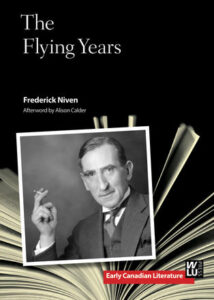

I’m pleased to announce the publication of the fifth and sixth volumes in the Early Canadian Literature series published by Wilfrid Laurier University Press: S. Frances Harrison’s The Forest of Bourg-Marie (1898), with an afterword by Cynthia Sugars (University of Ottawa), and Frederick Niven’s The Flying Years (1936), with an afterword by Alison Calder (University of Manitoba).
In The Forest of Bourg-Marie, originally published in 1898, Toronto author and musician S. Frances Harrison draws together a highly mythologized image of Quebec society and the forms of Gothic literature that were already familiar to her English-speaking audience. It tells the story of a fourteen-year-old French Canadian who is lured to the United States by the promise of financial reward, only to be rejected by his grandfather upon his return. In doing so, the novel offers a powerful critique of the personal and cultural consequences of emigration out of Canada.
In her afterword, Cynthia Sugars considers how The Forest of Bourg-Marie reimagines the Gothic tradition from a settler Canadian perspective, turning to a French-Canadian setting with distinctly New-World overtones. Harrison’s twist on the traditional Gothic plotline offers an inversion of such Gothic motifs as the decadent aristocrat and ancestral curse by playing on questions of illegitimacy and cultural preservation.
Originally published in 1935, Frederick Niven’s The Flying Years tells the history of Western Canada from the 1850s to the 1920s as witnessed by Angus Munro, a young Scot forced to emigrate to Canada when his family is evicted from their farm. Working in the isolated setting of Rocky Mountain House, Angus secretly marries a Cree woman, who dies in a measles epidemic while he is on an extended business trip. The discovery, fourteen years later, that his wife had given birth to a boy who was adopted by another Cree family and raised to be “all Indian” confirms Angus’s sympathies toward Aboriginal peoples, and he eventually becomes the Indian Agent on the reserve where his secret son lives. Angus’s ongoing negotiation of both the literal and symbolic roles of “White Father” takes place within the context of questions about race and nation, assimilation and difference, and the future of the Canadian West. Against a background of resource exploitation and western development, the novel queries the place of Aboriginal peoples in this new nation and suggests that progress brings with it a cost.
Alison Calder’s afterword examines the novel’s depiction of the paternalistic relationship between the Canadian government and Aboriginal peoples in Western Canada, and situates the novel in terms of contemporary discussions about race and biology.
These books can be purchased either in print or in epub format directly from the publisher or from your favourite bookseller.